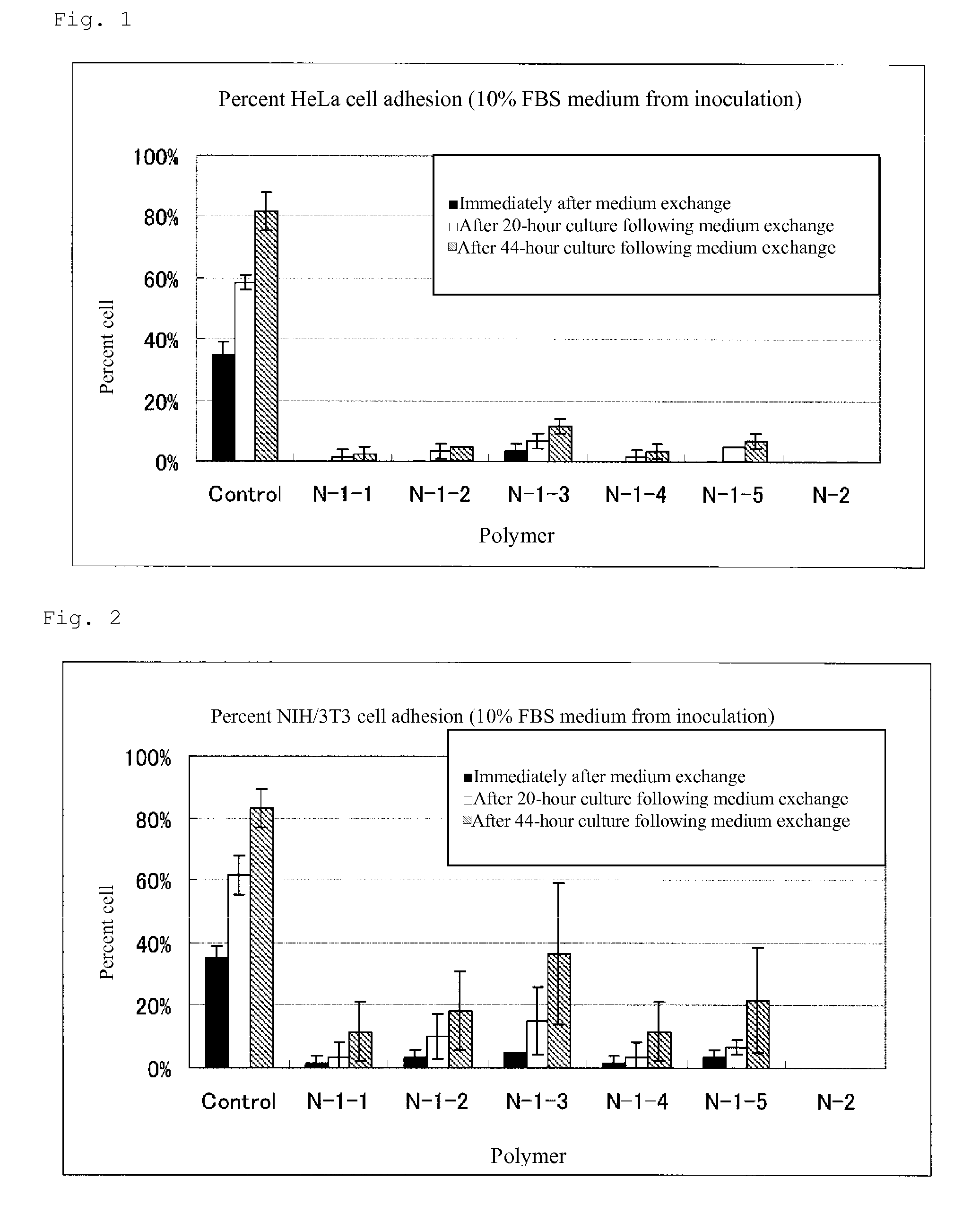Cell adhesion inhibitor
a cell adhesion inhibitor and cell technology, applied in the field of cell adhesion inhibitors, can solve the problems of reduced analysis accuracy or sensitivity, various dysfunctions, etc., and achieve the effect of excellent cell adhesion prevention effect and low cytotoxicity
- Summary
- Abstract
- Description
- Claims
- Application Information
AI Technical Summary
Benefits of technology
Problems solved by technology
Method used
Image
Examples
synthesis example 1
Synthesis of Copolymer (N-1-1)
[0191]Copolymer (N-1-1) was produced through the following synthesis scheme.
[0192]Glycidyl methacrylate (113 g), styrene (113 g), 2,2′-azobis(isobutyronitrile) (6.8 g) serving as a polymerization initiator, and N,N-dimethylformamide (475 g) were mixed together and transferred to a flask. While nitrogen was blown in the flask, the mixture was heated to 70° C. and allowed to polymerize for 6 hours. The reaction mixture was cooled to room temperature, and the formed solution was purified through re-precipitation in methanol, followed by drying under reduced pressure, to thereby produce copolymer (S-1-1).
[0193]The thus-produced copolymer (S-1-1) was found to contain a repeating unit derived from glycidyl methacrylate in an amount of 48 mol % and contain a repeating unit derived from styrene in an amount of 52 mol %. These repeating unit contents were determined through 13C-NMR.
[0194]Next, the thus-produced copolymer (S-1-1) (10 g), thioglycerol (32.1 g), an...
synthesis example 2
Synthesis of Copolymer (N-1-2)
[0198]Glycidyl methacrylate (170 g), styrene (56.8 g), 2,2′-azobis(isobutyronitrile) (6.8 g) serving as a polymerization initiator, and N,N-dimethylformamide (475 g) were mixed together and transferred to a flask. While nitrogen was blown in the flask, the mixture was heated to 70° C. and allowed to polymerize for 6 hours. The reaction mixture was cooled to room temperature, and the formed solution was purified through re-precipitation in methanol, followed by drying under reduced pressure, to thereby produce copolymer (S-1-2).
[0199]The thus-produced copolymer (S-1-2) was found to contain a repeating unit derived from glycidyl methacrylate in an amount of 67 mol % and contain a repeating unit derived from styrene in an amount of 33 mol %. The contents of these repeating unit were determined in the same manner as employed in Synthesis Example 1.
[0200]Next, the thus-produced copolymer (S-1-2) (10 g), thioglycerol (44.7 g), and N,N-dimethylformamide (95 g)...
synthesis example 3
Synthesis of Copolymer (N-1-3)
[0204]Glycidyl methacrylate (170 g), styrene (56.8 g), 2,2′-azobis(isobutyronitrile) (2.27 g) serving as a polymerization initiator, and ethyl acetate (450 g) were mixed together and transferred to a flask. While nitrogen was blown in the flask, the mixture was heated to 70° C. and allowed to polymerize for 8 hours. The reaction mixture was cooled to room temperature, and the thus-formed solution was purified through re-precipitation in methanol, followed by drying under reduced pressure, to thereby produce copolymer (S-1-3).
[0205]The thus-produced copolymer (S-1-3) was found to contain a repeating unit derived from glycidyl methacrylate in an amount of 67 mol % and contain a repeating unit derived from styrene in an amount of 33 mol %. The contents of these repeating unit were determined in the same manner as employed in Synthesis Example 1.
[0206]Next, the thus-produced copolymer (S-1-3) (10 g), thioglycerol (44.7 g), and N,N-dimethylformamide (95 g) w...
PUM
| Property | Measurement | Unit |
|---|---|---|
| Adhesion strength | aaaaa | aaaaa |
| Hydrophilicity | aaaaa | aaaaa |
| Hydrophobicity | aaaaa | aaaaa |
Abstract
Description
Claims
Application Information
 Login to View More
Login to View More - R&D
- Intellectual Property
- Life Sciences
- Materials
- Tech Scout
- Unparalleled Data Quality
- Higher Quality Content
- 60% Fewer Hallucinations
Browse by: Latest US Patents, China's latest patents, Technical Efficacy Thesaurus, Application Domain, Technology Topic, Popular Technical Reports.
© 2025 PatSnap. All rights reserved.Legal|Privacy policy|Modern Slavery Act Transparency Statement|Sitemap|About US| Contact US: help@patsnap.com



